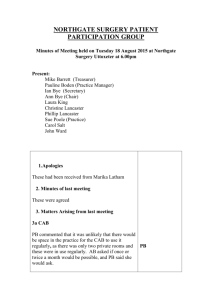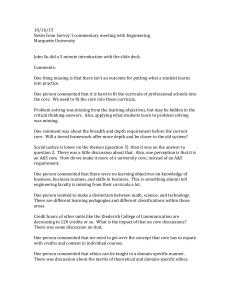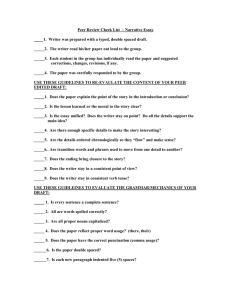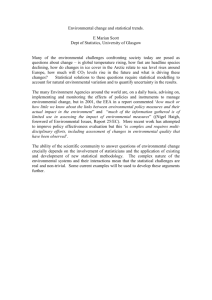Running head: MANAGING RISKS IN PROJECTS 1 Managing Risks
advertisement
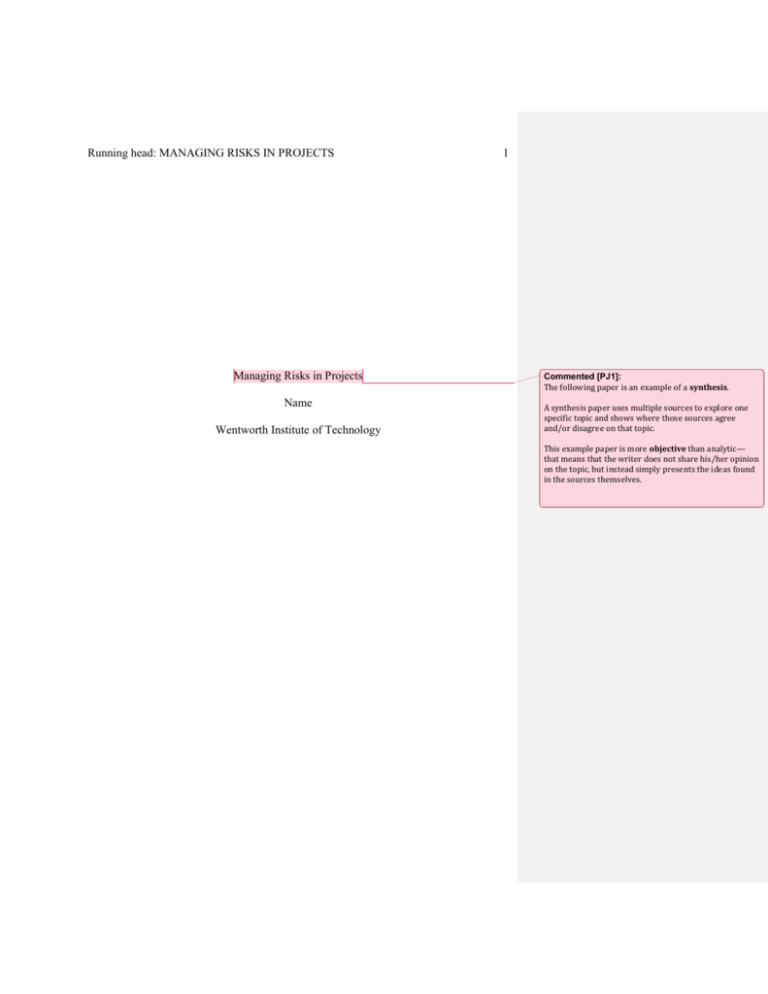
Running head: MANAGING RISKS IN PROJECTS Managing Risks in Projects Name Wentworth Institute of Technology 1 Commented [PJ1]: The following paper is an example of a synthesis. A synthesis paper uses multiple sources to explore one specific topic and shows where those sources agree and/or disagree on that topic. This example paper is more objective than analytic— that means that the writer does not share his/her opinion on the topic, but instead simply presents the ideas found in the sources themselves. MANAGING RISKS IN PROJECTS 2 Abstract Commented [PJ2]: An abstract introduces the topic and offers a brief summary of the paper’s key points. This paper explores four articles on risk management practices for project managers. Commented [PJ3]: In the topic sentence of the abstract, the writer identifies the paper’s topic. These sources look into the process of risk management and how it may be different than Commented [PJ4]: In the remainder of the abstract, the writer identifies the key points that he/she will develop using the source material. the process most project managers are used to. Like much of project management, there is no one way or practice that will guarantee success in risk management. This paper will delve into how risk management can be implemented to offer the best chance for success. MANAGING RISKS IN PROJECTS 3 Managing Risks in Projects Risk management is both the science and art of identifying and planning for various problems that may be encountered while working on a project. More than ever before, organizations are launching innovative projects in order to stay on top of their Commented [PJ5]: The writer begins the essay by introducing the topic (risk management) and by giving a definition of that term. industries. As rapidly changing technologies become more and more ubiquitous, projects are marked by “increasing complexity, uncertainty, and ambiguity” (Podean, Benta, & Mircean, 2010). In response to these complexities, organizations and the project managers they employ realize that planning for the unexpected is just as important as achieving strategic objectives. Projects that fall victim to various risks can upset the iron triangle of scope, budget, and time. Planning for risks helps to ensure quality deliverables, on time and on budget (De Meyer, Loch, & Pich, 2002). Ongoing planning during a project lifecycle Commented [PJ6]: The writer begins weaving source information into the paper. Notice how the writer leads into the quoted material and follows up afterward with framing information and context—the quote isn’t just plopped in there without introduction or explanation. For additional tips, view the Learning Center handout on Integrating Sources. means that executing risk management procedures may be as dynamic as executing the Commented [PJ7]: There are no quotes around this idea, but it is information gathered from a source and rephrased in the writer’s own words—it is a summary. project itself (Stanleigh, n.d.). Summaries of source material are very common in APA Style and are often preferred over quotations. Risk Management Steps Stanleigh (n.d.) held that there are four main steps in the risk management process: identifying the risk, assessing the risk, developing responses to the risk, and developing contingency plans or preventive measures for the risk. Identify the Risk During the identification step, the project team must brainstorm all possible sources of risk (Stanleigh, n.d.). This is one of the most important and difficult steps in You still need to cite when you summarize. In this example, the writer has included all the necessary citation information in the parentheses at the end of the sentence. Commented [PJ8]: APA Style recommends breaking a paper down into sections if it helps with readability and organization. Because risk management is process-based, it makes sense for the writer to break down the process of risk management into sections. Notice how the “four main steps” of this process, introduced in this main section, are broken down into four sub-sections that follow. For addition section tips, view the Learning Center handout on Sections. the process, since “it’s not possible to anticipate everything that can put a project’s plan or schedule at risk” (Gray, 2005). Commented [PJ9]: Here, the writer uses multiple sources to develop the main point of this section. Using one source, they identify a method for identifying risk (brainstorming), and using another, they elaborate on the importance and shortcomings of that method. MANAGING RISKS IN PROJECTS 4 Gray (2005) itemized the common types of risk to look for: financial resource risk (example: funding is cut), human resource risk (example: key team member leaves during a project), supply risk (example: flow of resources from a third party stops), and finally, quality risk (example: project outcomes compromised because of rushing to finish). Beyond considering these fundamental risks, balancing when to end the identification process is important, as having to plan for every possible outcome is impossible. Assess the Risk A high level assessment of risk would categorize the various risks that were identified as either acceptable or unacceptable (Stanleigh, n.d.). To do this a project manager must assess the negative impact each risk may pose, ideally drilling it down to a dollar value (Gray, 2005). Yet while a dollar value is good for putting impact into perspective, there are additional merits to doing a mixture of qualitative and quantitative assessment: “Past experience, gut feeling, lessons learned and historical data should all be weighed in when making judgments about risk” (Podean et al., 2010). Additionally, Podean et al. (2010) recommended assessing if project components are on the critical path to get an idea if they might delay the project overall. This type of assessment is called “duration cruciality” and allows managers to see how an isolated risk could impact the project as a whole. Develop Responses to the Risk Responses to risk fall under three main categories: avoidance, mitigation, and acceptance (Stanleigh, n.d.). Say, for instance, a project consists of developing new memory to go inside PCs and the project team identified a risk in that a supplier may be unable to fulfill the quantity of chips the project needs. Possible solutions would be to Commented [PJ10]: When this source was first cited, all author names were written out (Podean, Benta, & Mircean, 2010). For sources with more than two authors, all citations after the first need only list the first author followed by “et al.” For additional tips, view the Learning Center handout on In-Text Citations. Commented [PJ11]: In this paragraph, 3 of the writer’s 4 sources are used to develop the main point of the section. Information from each source is arranged in a way that helps the reader see how each source corresponds and relates to each other. MANAGING RISKS IN PROJECTS 5 find an alternative supplier for the chips (avoidance), find a variety of suppliers for the chips (mitigation), or develop a contingency plan if the supplier falls through (acceptance). Develop a Contingency Plan or Preventative Measures for the Risk During the final step of risk management, a response to the identified risks must be agreed upon and implemented. A contingency plan should be ready to be put into action at a moment’s notice if the risk becomes a reality (Stanleigh, n.d.). If the acceptance option was chosen in the example above, this might include drafting a list of backup suppliers or developing an alternative chip in-house. Understanding what needs to be done in case a risk becomes a reality alleviates some of the stress of the situation and helps to prevent the need for crisis management (Stanleigh, n.d.). Uncertainty Management Like Gary (2005), De Meyer, Lock & Pich (2002) agreed that it’s impossible to anticipate every risk a project may face: “Uncertainty is an inevitable aspect of most projects” (De Meyer, et al., 2002). Uncertainty can be classified into four types (from least uncertain to most uncertain): variation, foreseen uncertainty, unforeseen uncertainty and chaos. These classifications do not necessarily go against traditional project risk management theory but in fact complement it in terms of how one would assess various risks. De Meyer et al. (2002) stressed that risks in each of these four classifications require the project manager to manage differently. The less uncertainty there is about a risk the more a project team can rely on planning. In contrast, the more uncertainty there is about a risk, the less a project team can rely on planning. In the case of significant Commented [PJ12]: Here, the author creates a new section to discuss an aspect of risk management that is slightly different from what has previously been discussed. Separating this information into its own section helps the reader digest it and see how it both relates to the previous points made. MANAGING RISKS IN PROJECTS 6 uncertainty, a project team must keep an open mind as they move forward and learn as the project develops (De Meyer et al., 2002). Conclusion Project risk management does not guarantee that projects will be a complete success but it certainly helps. As Stanleigh (n.d.) noted, “Proper risk management will reduce not only the likelihood of an event occurring, but also the magnitude of its impact.” Organizations have a lot to gain when proper risk management techniques are implemented throughout the project lifecycle. Commented [PJ13]: The conclusion offers a concise wrap-up. In this example, the writer reminds the reader why, overall, risk management is important. MANAGING RISKS IN PROJECTS 7 References De Meyer, A., Loch, C. H., & Pich, M. T. (2002). Managing project uncertainty: From variation to chaos. MIT Sloan Management Review, 60-67. Gary, L. (2005, October). Managing project risk. Harvard Management Update. Podean, I. M., Benta, D., & Mircean, C. (2010, April). Overlapping boundaries of the project time management and project risk management. Informatica Economica, 14, 156-163. Stanleigh, M. (n.d.). Risk management...the what, why, and how. Business Improvement Architects. Commented [PJ14]: View the Learning Center Handout on the References page to learn more about formatting. This writer has used four print articles for source material. Your References page may look a little different if you use a variety of sources, like websites, online articles, podcasts, and more.

